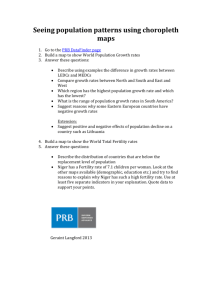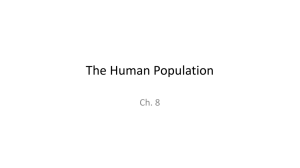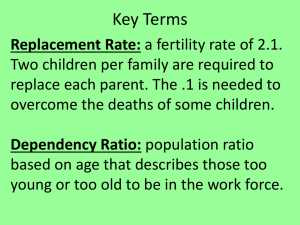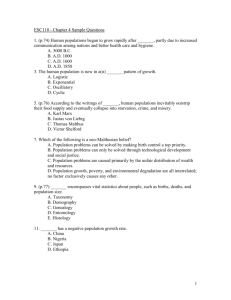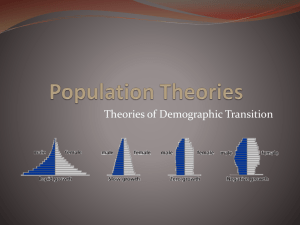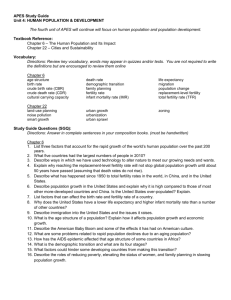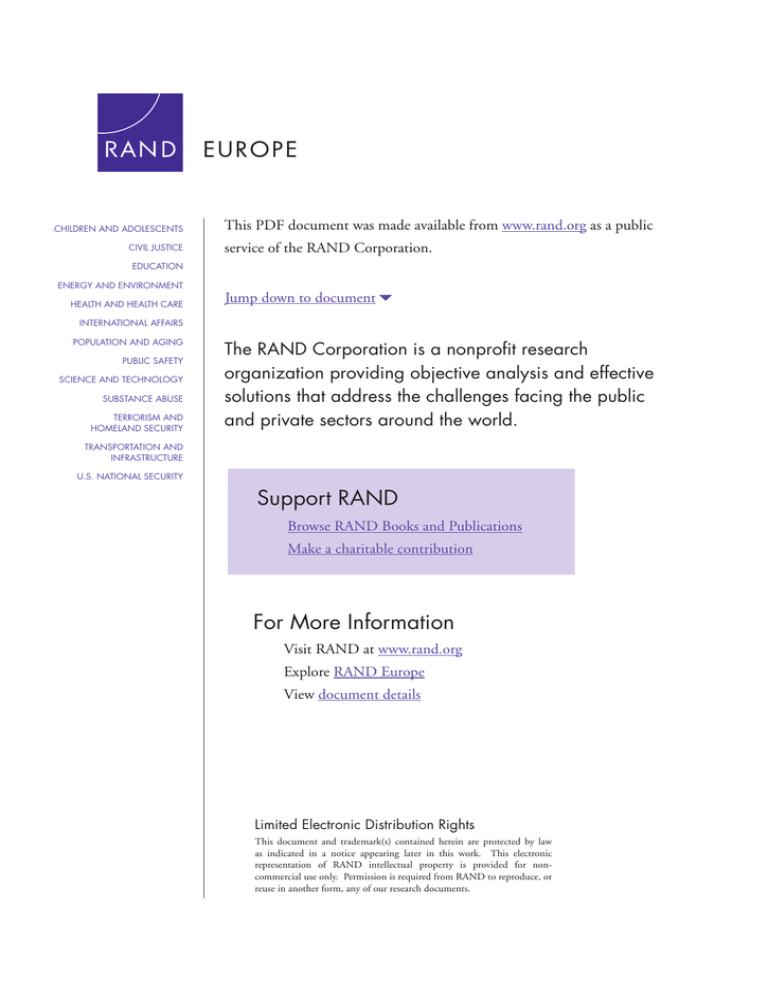
CHILDREN AND ADOLESCENTS
CIVIL JUSTICE
This PDF document was made available from www.rand.org as a public
service of the RAND Corporation.
EDUCATION
ENERGY AND ENVIRONMENT
HEALTH AND HEALTH CARE
Jump down to document6
INTERNATIONAL AFFAIRS
POPULATION AND AGING
PUBLIC SAFETY
SCIENCE AND TECHNOLOGY
SUBSTANCE ABUSE
TERRORISM AND
HOMELAND SECURITY
The RAND Corporation is a nonprofit research
organization providing objective analysis and effective
solutions that address the challenges facing the public
and private sectors around the world.
TRANSPORTATION AND
INFRASTRUCTURE
U.S. NATIONAL SECURITY
Support RAND
Browse RAND Books and Publications
Make a charitable contribution
For More Information
Visit RAND at www.rand.org
Explore RAND Europe
View document details
Limited Electronic Distribution Rights
This document and trademark(s) contained herein are protected by law
as indicated in a notice appearing later in this work. This electronic
representation of RAND intellectual property is provided for noncommercial use only. Permission is required from RAND to reproduce, or
reuse in another form, any of our research documents.
This product is part of the RAND Corporation monograph series. RAND monographs present major research findings that address the challenges facing the public
and private sectors. All RAND monographs undergo rigorous peer review to ensure
high standards for research quality and objectivity.
Low Fertility and
Population Ageing
Causes, Consequences,
and Policy Options
Jonathan Grant, Stijn Hoorens, Suja Sivadasan, Mirjam van het Loo,
Julie DaVanzo, Lauren Hale, Shawna Gibson, William Butz
Prepared for the European Commission
The research described in this report was conducted by RAND Europe. The contents of this publication
do not necessarily reflect the opinion or position of the European Commission, Directorate-General for
Employment and Social Affairs. The report remains an intellectual property of the Commission. The
RAND Corporation funded the publication of this report with money it earned or raised from donors.
The RAND Corporation is a nonprofit research organization providing objective analysis and effective
solutions that address the challenges facing the public and private sectors around the world. RAND’s
publications do not necessarily reflect the opinions of its research clients and sponsors.
R® is a registered trademark.
© Copyright 2004 European Commission
All rights reserved. No part of this book may be reproduced in any form by any electronic or mechanical
means (including photocopying, recording, or information storage and retrieval) without permission in
writing from the copyright holder.
Published 2004 by the RAND Corporation
1776 Main Street, P.O. Box 2138, Santa Monica, CA 90407-2138
1200 South Hayes Street, Arlington, VA 22202-5050
201 North Craig Street, Suite 202, Pittsburgh, PA 15213-1516
Newtonweg 1, 2333 CP Leiden, The Netherlands
Grafton House, 64 Maids Causeway, Cambridge CB5 8DD, United Kingdom
Uhlandstraße 14, 10623 Berlin, Germany
RAND URL: http://www.rand.org/
RAND Europe URL: http://www.rand.org/randeurope
To order RAND documents or to obtain additional information, contact
Distribution Services: Telephone: (310) 451-7002;
Fax: (310) 451-6915; Email: order@rand.org
Summary
Europe’s Demographic Challenge
Nearly all European nations are experiencing long-term downtrends in fertility, and
consequently, ageing of their populations. Fertility rates are now below replacement level (2.1
children per couple) in nearly all countries. As a result, natural population growth rates are
entering periods of declining growth or outright decrease. At the same time, the proportion of
elderly dependants continues to grow while the working-age population declines as a share of the
overall population. Moreover, net immigration, which potentially could offset declines in
working-age population, remains generally low in most European countries.
Taken as a whole, these demographic trends could have potentially damaging consequences for
European economies. For example:
•
•
•
•
as the working-age population decreases, countries experience declines in human capital,
which potentially reduces productivity;
pension and social insurance systems can become heavily burdened;
the ability to care for the growing elderly population declines as household sizes decrease;
the elderly face sharply increased health care needs and costs.
In turn, the se developments are likely to pose significant barriers to achieving the goals of the
European Union (EU) Social Agenda: full employment, economic growth, and social cohesion.
Concern over these trends has sparked intense debate over the most effective policies to reverse
them, or at least mitigate their consequences. Three broad policy approaches have been
considered:
1. encourage marriage or cohabitation and more childbearing among younger couples;
2. increase immigration of working-age people into countries that need them; and
3. reform social policy more generally, in order to ameliorate the negative consequences of
these trends – measures could include raising the retirement age or encouraging more
women to enter the workforce.
However, research-based information to inform this debate remains sketchy. Many aspects of the
relationship between national policies and demographic trends are still not well understood, and
it remains difficult to disentangle the effects of specific policy initiatives from the effects of
broader social, political, and economic conditions.
xiii
xiv
Low Fertility and Population Aging – Causes, Consequences and Policy Options
Study Purpose and Approach
This study is intended to improve understanding of the interrelations between policy and
demographic change. It examines the interrelations between European government policies and
demographic trends and behaviour, and assesses which policies can prevent or mitigate the
adverse consequences of current low fertility and population ageing.
To conduct this inquiry, the research team created a framework that highlights the
interrelationships among government policies, macro-level conditions (such as economic trends,
medical advances, and technological progress) and household-level demographic behaviour, all of
which combine to influence population factors, such as migration and pop ulation age structure.
Guided by this framework, three research tasks were carried out:
1. the research literature was reviewed on the relationship between national level policies
and (a) macro-level demographic trends and (b) micro-level household behaviours;
2. data were examined on European demographic trends; and
3. case studies of five particular countries of interest were conducted: France, Germany,
Poland, Spain, and Sweden.
Conclusions and Implications for Policy
The study reached five main conclusions.
1. Replacement immigration cannot prevent population ageing or its consequences.
2. National policies can slow fertility declines under the right circumstances.
3. No single type of policy intervention will necessarily slow fertility declines.
4. What works in one country may not work in another. Social, economic, and political
contexts influence policy impacts. Therefore, policies indirectly aimed at fertility which
target improvements in broader conditions may have beneficial fertility effects.
5. Population policies take effect slowly, and therefore may be politically less attractive.
We discuss below each of these conclusions in more depth and explore their implications for
policy. This discussion needs to be seen in the context of the complex political debate that is
associated with policies that aim to affect demographic behaviour. It is a legitimate question to
ask whether the state has a right to intervene and influence the private discussion of individuals
and their partners in making decisions about their own fertility and family formation.
Population Ageing Cannot Be Remedied through Replacement Immigration
Replacement immigration does not offer a feasible solution to the problem of population ageing.
The sheer numbers of immigrants required to offset population ageing in the EU and its Member
States would be unacceptable in Europe’s current socio-political climate. A record number of
annual immigrants would be needed to offset ageing – at a time when the EU and its Member
States are actively trying to prevent immigration. Thus the debate is more appropriately on
whether immigration may be effectively used to slow as opposed to prevent population ageing.
Here it should be noted that even if large numbers of working-age immigrants were permitted to
enter EU nations, it remains unclear whether this would slow population ageing in the short term
but simply postpone the problem in the long term. These immigrants would themselves age, so
producing the same imbalances in national age structures.
However, replacement migration is not necessarily a closed topic. Important questions remain
unanswered. For example, United States and European immigration policies have diverged since
the 1980s. The US has adopted a more open stance toward the immigration of skilled workers
Summary
xv
compared with the relatively closed approach taken by Member States. Over this same period,
there has been a higher rate of productivity increases in the US, which have contributed to rates
of economic growth higher than in the EU. Thus, it would be valuable to understand whether
the more open US immigration policy helps to explain its higher rate of economic growth.
Government Policies Can Slow Declines in Fertility Rates
Government policies can have an impact on fertility. For example, our case studies show instances
where countries that experienced a relaxation of pronatalist policies saw declines in fertility. Two
former “Iron Curtain” nations – Poland and the German Democratic Republic (GDR) –
witnessed declines in fertility after pronatalist policies were eased. The GDR provides examples of
the introduction of several family policy packages, with varying success. The 1986 policy package
in the GDR had little impact, while the 1972 measures helped to reduce fertility. The purely
economic incentives of the East German 1976 family policy package appear to have had an
immediate impact on the number of births. The total fertility rate increased from 1.54 in 1975 to
1.94 in 1980. However, the longer-term effects of this policy package are less visible, perhaps
because they affect the timing more than the overall number of births.
In Poland, the introduction of pronatalist policies in the 1970s reversed decreasing fertility until
the mid-1980s. While fertility did decrease again in the late 1980s, during the 199 0s the decrease
in fertility occurred even faster with the onset of economic transformation, and its accompanying
social, economic, and policy changes.
Currently, Spain has the second lowest rate of fertility of the EU Member States (behind Italy),
and lacks a clear population policy. However, a generation ago (in 1971) Spain had the second
highest European fertility rate. The dramatic decline in fertility since then is associated with a
shift from the pronatalist Franco regime – prohibiting contraception, honouring large families,
etc. – to a democratic regime with a passive population policy.
In contrast with Spain, France currently has the second highest rate of fertility in Europe (behind
Ireland) and has one of the most interventionist set of policies aimed at encouraging families to
have children. Some people might find the relatively high fertility rate in France surprising, since
it was the first country in Europe to witness a fertility decline. However, the long-term fertility
decline has prompted a deep and ongoing concern about population, resulting in the drafting of
the Family Code in 1939. Family policy has been high on the political agenda ever since,
resulting in relatively high fertility rates.
In most countries, policies that affect fertility typically have other objectives. For example, in
Sweden, family policy and employment policies are linked to the primary objective of allowing
couples to combine family formation with work. Thus, it would be wrong to describe the primary
aim of policies such as parental leave, public childcare, etc. as increasing fertility (or preventing its
further fall). The impact on fertility is secondary.
In turn, fertility declines, and subsequent reverses, may be attributable less to policy changes than
to the social and economic environment. In Spain, for example, low fertility rates have been
explained by (among other things) high unemployment rates for people under 30, high housing
costs, and the tendency of young adults to live with their parents for more years than in other
European countries. Thus, an indirect policy that stimulates economic growth may reduce
unemployment, increase disposable incomes, and allow young couples to set up home. Making
housing more affordable could have a similar effect.
No Single Policy Works
No single policy intervention by itself will reverse low fertility in all cases. Historically,
governments have had success in slowing fertility declines through a variety of interventions. For
example, in recent decades France has had success by focusing on the birth of the third or
xvi
Low Fertility and Population Aging – Causes, Consequences and Policy Options
subsequent child. However, the literature suggests that this is less attributable to a single policy
mechanism than to its ability to create an environment, that encourages childbearing. This
environment is created by a combination of policies that jointly serve this aim.
Sweden has been successful in reversing fertility declines through a different set of policies. Its
policy of parental leave during the 1980s allowed many women to raise children and remain in
the workforce. In Sweden, neither high-quality childcare nor extensive parental leave on
reasonable economic terms appears to be individually responsible for the relatively high fertility
rates in the late 1980s. It appears that the combination of policies targeted at equal responsibilities
for men and women as wage earner and care provider, and at the welfare of children, was essential
for supporting family formation and the quality of family life.
In the former GDR, the introduction of a family policy scheme in 1976, including prolonged
maternity leave, paid educational leave, interest-free loans to newly-wed couples, substantially
raised birth grants, increased monthly family allowances, and improved day care, had a
subsequent impact on fertility. Again, it was not a single measure, but the generosity of the whole
package that had an effect on family formation. However, a similar package that was introduced
in 1986 did not have the desired effect.
Finally, what works in one country may not work in another. The literature showed that a
correlation between the magnitude of social transfers to the family and fertility levels exists in
several countries while this correlation is absent in others, although it should be stressed that this
in itself does not imply caus ality. Therefore, family policies may be necessary, but not sufficient,
for affecting fertility levels.
While the countries above employed a “suite” of policies, there is no evidence that such an
approach was coordinated or intended to affect fertility per se. However, if the EU wishes to
prevent (as opposed to mitigate) population ageing and the decline in human capital over the
next generation, it will be necessary to acknowledge – and “mainstream” – population policy.
This will still mean that governments can use either direct or indirect policy interventions, but
the primary and secondary consequences of those interventions will be openly explicit.
Political, Economic, and Social Contexts Influence Policy Impacts
Different interventions have varying effects because of the complex and shifting political,
economic, and social contexts within which they are implemented. This is perhaps best illustrated
with the political transitions of the GDR, Poland, and Spain. The fertility decline in the former
GDR after unification cannot be attributed to specific policy, but rather to a changing social
environment. Women who faced the unification with concerns about their personal economic
situation were less likely to have children in the following months. Similarly, the transition to a
free market economy in Poland changed the economic environment and incentives for
childbearing and also diffused Western ideas and values to broad segments of the public. In
Spain, a dramatic decline in fertility was associated with the democratic rule that emerged
following the dissolution of Franco’s regime.
France has demonstrated a long-term concern that declining fertility poses a threat to its
economy. As a result, the French have been more open to state intervention in family life than
their counterparts in some other European countries, such as Spain. Although we did not identify
any studies that focus on the degree to which the general public’s acceptance of family policy
enhances the effectiveness of that policy, we conjecture that openness to state intervention in
family life might improve the effectiveness of policies to affect fertility.
In Sweden, the economic context is an important determinant of fertility. There, levels of
(female) earnings are positively related to levels of childbearing. Thus, policies to encourage
female labour force participation help to promote economic growth, but they will ultimately
Summary
xvii
reduce fertility unless they are accompanied by family-friendly policies that enable women to
combine childbearing and rearing with work.
Population Policies Take Effect Slowly
Government policies that are intended to reverse fertility declines, whether directly or indirectly,
tend to have a long-term focus and require many years to implement. For this reason, they tend
to lack political appeal as well as political champions. Some population policies may have an
immediate impact (for example, abortion policy), but these are exceptions. The final stage in the
cycle for population policies to affect fertility takes a generation before they affect the number of
new entrants to the labour force.
This has two implications. First, there is a disconnection between electoral cycles (typically 4–5
years) and the longer cycle of population policy. This means that politicians have lim ited
incentive to advocate such policies, especially when political capital could be expended needlessly
in entering a contentious policy domain. Second, partly as a result of the latter point, politicians
tend to focus on policies that have shorter time horizons. These include, for example, social
security reforms that aim to reduce the economic burden that states face with declining
contributions to “pay-as-you-go” welfare systems. There is a considerable debate in the literature
about the desirability, feasibility, and effectiveness of these policies. Related to this is the need for
cost containment of welfare as the population ages, notably through the rationing of health care.
Third, one way to mitigate the adverse consequences of low fertility and population ageing is to
increase human capital by encouraging people to work longer. This can mean promoting a longer
working life and encouraging new entrants into the workforce, such as women. Related to this is
the need to develop “pro-elderly” policies that encourage elderly people to be active and
productive members of the workforce.
Finally, employment policies that encourage women to enter the workforce can have a perverse
effect on fertility if women choose a career over family. However, Sweden provides a counter to
this generalisation: employment policy and family policy have gone hand-i n-hand. During the
1970s and 1980s, Sweden created the conditions in which the adverse effects of family formation
from labour participation were minimised and equally shared between both parents. These
conditions enabled relatively high fertility and high female labour participation to coincide,
which was unique in Europe. However, from the Sweden case study it appears that this
equilibrium may be unstable, since it seems to depend on a thriving economic environment.
Areas for Further Research
The study identified several areas where gaps in knowledge exist and where improved
understanding could provide a sounder basis for policy decisions. To address these gaps, the stud y
proposes a short research agenda.
•
•
•
•
Examine the relationship between open immigration and high economic growth in the
US and closed immigration policy and relatively lower economic growth in Europe.
Identify natural experiments that can shed light on the impact of particular policy
changes and collect data to enable “before/after” comparisons.
Study the role of contextual factors in demographic change. It is important to
understand the magnitude of the effects of different population policy interventions in
different contexts, and at a regional as well as country level.
Review the existence and quality of data for studying the relationship between
demographic change and policy, and provide a standard taxonomy for direct and indirect
policies.
xviii
Low Fertility and Population Aging – Causes, Consequences and Policy Options
•
Assess the sustainability of efforts to mitigate the adverse socio-economic consequences of
population ageing.
Concluding Observation
In conclusion, replacement migration and policies to increase fertility are unlikely to stop the
ageing of Europe’s population, although they may slow it down. Thus, it is important for the
European Commission, Member States and Applicant Countries to consider other ways to pursue
the Social Agenda of full employment, economic growth, and social cohesion.

